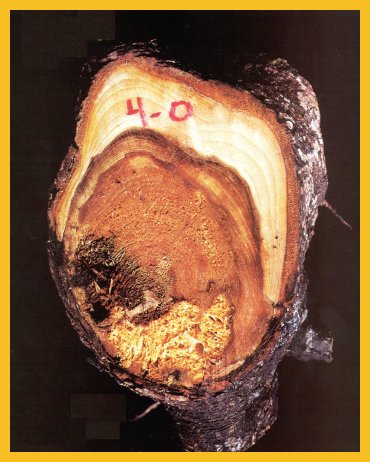 This red
spruce root (Picea rubens) has compartmentalized the Armillaria infection,
but space for storage has been greatly decreased. Note the fungus
wedge in the bark.
This red
spruce root (Picea rubens) has compartmentalized the Armillaria infection,
but space for storage has been greatly decreased. Note the fungus
wedge in the bark.
Tree Biology
 This red
spruce root (Picea rubens) has compartmentalized the Armillaria infection,
but space for storage has been greatly decreased. Note the fungus
wedge in the bark.
This red
spruce root (Picea rubens) has compartmentalized the Armillaria infection,
but space for storage has been greatly decreased. Note the fungus
wedge in the bark.
How do root rots kill trees? Do they? Are the "killer
fungi" the primary cause?
What is meant by predisposition? Who is Sorauer, and why do we need
to know something about his work? It is time to take a closer look at root
rots, and especially those caused by species of Armillaria. I say species
of Armillaria because we know that more species than Armillaria mellea
are involved.
The subject of armillaria root rot has been discussed many times.
I will try to give some information that is not usually reported. First,
as with any problem, it is important to understand the background information
and some history . That is why I plan to include predisposition and the
father of the subject, Paul Sorauer, in this brief discussion.
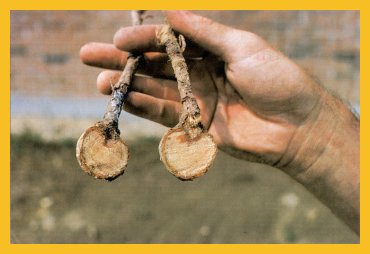
Decay associated with a species of Armillaria in the roots of
this American beech was compartmentalized as it spread into the tree base.
The year 1874 is a good time to start. This is the year that Robert Hartig published his famous book on important diseases of forest trees. The first subject in this book is armillaria root rot. Hartig called the fungus Agaricus (Armillaria) melleus. Hartig took the disease concepts of Anton De Bary and Gotthelf Kuhn and applied them to trees. This was a monumental moment for all trees. Hartig proved that the fungus fruiting on a wound was the same as the fungus causing the rot behind the wound. The single fungus, single disease concept was accepted and began to move quickly. One reason was that problems of decay in living trees and wood products were considered very economically important.
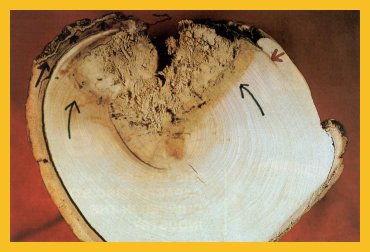 Decay associated
with a species of Armillaria was weakly compartmentalized in the base of
this Populus tremuloides (arrows in the wood). The red arrow shows the
barrier zone and the arrow at left shows the fungus wedge that spread into
the bark.
Decay associated
with a species of Armillaria was weakly compartmentalized in the base of
this Populus tremuloides (arrows in the wood). The red arrow shows the
barrier zone and the arrow at left shows the fungus wedge that spread into
the bark.
Also in 1874, another book was written. It was a handbook for plant
diseases by a person history seems to have forgotten, or left behind, Paul
Sorauer. More than half of his book was on abiotic causes of diseases and
predisposition. Although his book was reprinted six times prior to 1934,
his concepts on predisposition just were not able to compete with the concepts
of a single pathogen for a single disease, including decay in trees and
wood products. The strange part of this story is that arguments went
on for decades about whether decay in trees could even be considered a
disease. Why? Because decay was said to be the breakdown of dead heartwood.
How could you have a disease of dead matter? The heartrot concept that
followed was really a decomposition concept. The response of the living
tree to the wounds and the infections was not considered. Also, isolations
for fungi were done on malt agar alone, which does not support growth of
bacteria and non-decay causing fungi. Consequently, associated microorganisms
were not detected frequently. Over the years, the concepts of Paul Sorauer
have made more sense to me. A major reason why his work is so difficult
to understand and accept is because it is difficult to remember the many
seemingly unimportant events and agents that accumulate over time and predispose
a host to pathogens that could kill or cause decay. It is easy to see and
touch the decayed wood, the large sporophores and the declining tree. If
the sporophores are obvious when the tree is declining, the fungus inside
the tree that relates to the sporophores must be the cause. This story
repeats and repeats.
This point is well-taken with armillaria root rot, How could anyone
say that a declining tree that has many mush- rooms at the base is not
dying because of the fungus infection? The mushrooms of Armillaria species
do indicate without a doubt that the fungus on the inside is the same as
the fungus of the fruiting bodies on the outside. Hartig proved this. We
hear it said many times over and over that Armillaria is a tree killer
or the armillaria root rot killed my tree!
At this point, I'm sure Sorauer is turning over again, as a pinwheel,
in his grave.
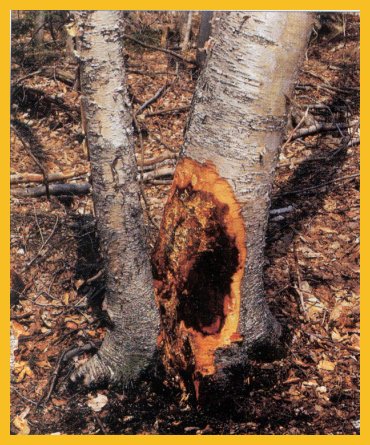 White
spreading "fans" of mycelium from an Armillaria infection are shown at
the base of this white birch. As tree defense decreases from root infections,
the pathogen often grows rapidly into the bark. Why are root rots called
killers?
White
spreading "fans" of mycelium from an Armillaria infection are shown at
the base of this white birch. As tree defense decreases from root infections,
the pathogen often grows rapidly into the bark. Why are root rots called
killers?
Have you ever wondered why there are so many fungi known to cause
decays in trunks of trees, yet few are cited as the cause of decline and
death? The answer usually given is that the rots are compartmentalized.
Don't roots compartmentalize infections also? Of course they do! And, they
usually do it more effectively than trunks. So, why is it said so often
that root-rotting fungi, such as Armillaria species, kill trees?
A major problem is that trunk wood and root wood is thought to be
similar. When you start with a false premise, confusion or myth will always
follow. Root wood is different from trunk wood in many ways. Trunk wood
and root wood both store starch in living cells, but root wood has a much
greater percentage of living cells than trunk wood. When I2- KI is poured
over the cut surfaces of trunk wood and root wood of the same tree, the
root wood will be much darker in color, indicating more starch in more
living cells.
Starch is not soluble in water. However, when water molecules
are chemically "inserted" back into starch by way of amylase enzymes, the
starch is converted back to glucose. Glucose is the fuel for life. Glucose
also "runs" the defense system. When glucose reserves are high, defense
is high. When glucose reserves are low, defense is low. When defense is
high, we say the organism is healthy. Most pathogens are opportunists and
wait until defense is low before they attack.
Before I continue with this subject, I should give some other characteristics
of root wood. Roots also mechanically support the tree. Root wood does
have lignin, but not as much as trunk wood. This is best shown when you
cut trunk wood and root wood of the same tree and feel the difference.
It is much easier to cut root wood than trunk wood. Roots transport liquids
that contain essential elements for tree life. The diameters of root wood
vessels, or tracheids, are usually larger than those in trunk wood.
Species of Armillaria have a unique ability to rot wood and form
wedges into the root bark. In a sense, Armillaria species are root canker
rots because this is also an ability of canker rots of trunks. And, the
fungi that incite trunk canker rots usually infect branch stubs that have
weak protection zones. Protection zones at the base of the trunk branches
or root branches depend on energy reserves for protection substances. The
story repeats as energy reserves decrease, protection zones become weaker
and finally lose their ability to resist invasion by the pathogens.
Canker rots are caused by fungi that can rot wood and form wedges
into the bark. When conditions are best for rotting wood, they rot wood.
When conditions are not best for rotting wood, the pathogens form large
wedges into the bark. As the bark wedges increase in size, they squeeze
and eventually kill the cambium from the bark side inward. Then the defenseless
wood beneath the bark is easily invaded by the pathogens. In time, the
expanded volume of infected wood is compartmentalized. As this host-pathogen
"seesaw" continues, the host can "win" if compartmentalization is fast
and effective, and enough new wood is formed to store more energy reserves.
The host begins to "lose" when the pathogens begin to occupy more and more
space.
Perennial trunk cankers have a similar ability to grow slightly
in wood and rapidly in bark. The difference is that the fungi that incite
perennial trunk cankers are not able to grow rapidly in wood and cause
decay.
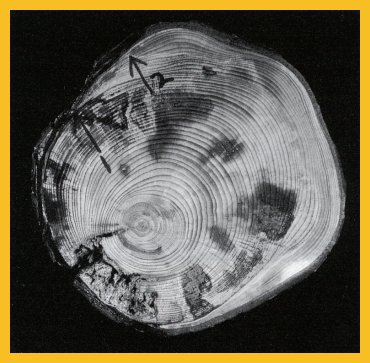 Arrow 1 in
this spruce root (Picea rubens) shows the position of an Armillaria bark
wedge that formed several years before the second wedge formed, as shown
by arrow 2.
Arrow 1 in
this spruce root (Picea rubens) shows the position of an Armillaria bark
wedge that formed several years before the second wedge formed, as shown
by arrow 2.
Time for Paul Sorauer to enter again. How does his predisposition
concept fit into this story? First, think about where problems blamed on
species of Armillaria are most serious. I think you will agree that in
urban areas it will be in places where intensive work is done to provide
beautiful landscapes. In forests, it will be where the trees are heavily
cut - as in clear cuts, plantation thinning or intensive selection-repeated
at short time intervals. There must have been a reason why Robert Hartig
spent 30 years studying Armillaria spp. And why it was the first subject
in his first book. The forestry management methods in that part of the
world favor conditions that invite species of Armillaria and other root-rotting
fungi. In forests, Armillaria spp. also follow defoliations, such as those
caused by gypsy moth caterpillars, and diseases such as beech bark disease
and oak wilt. Also, mushrooms of Armillaria species are common on stumps.
Removal of the top does not mean that the woody roots die immediately.
As the energy reserves in the roots decrease, the point is reached when
defense systems no longer function. The "clean-up crews" enter. Tree removals
in urban areas, even when the stumps are ground down, still provide root
wood for opportunistic pathogens. As populations of the pathogens build
up, they may attack trees that have stronger defense systems.
What Sorauer said was that when conditions or other agents cause
defense to decrease, predisposition starts. The hosts become easier to
attack or the host is predisposed to attack.
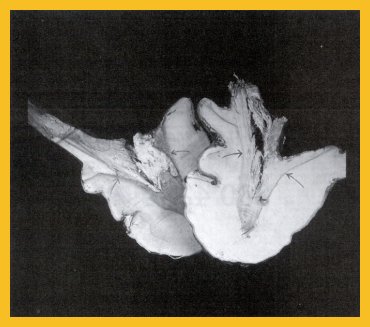 As Armillaria
infections and infections associated with other root-rotting fungi spread
into larger roots, the infections are compartmentalized, but storage space
is decreased to the point where defense processes no longer function. Then,
the pathogens grow rapidly in the host.
As Armillaria
infections and infections associated with other root-rotting fungi spread
into larger roots, the infections are compartmentalized, but storage space
is decreased to the point where defense processes no longer function. Then,
the pathogens grow rapidly in the host.
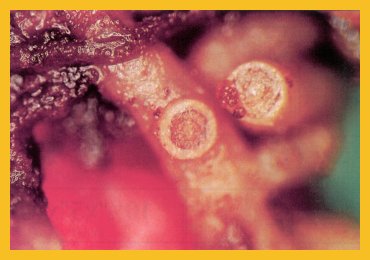 The broken
mycorrhiza shows the basal attachment that could be an infection court
for other root pathogens in the soil. Under ideal conditions, an abscision
zone forms first at the base and then the mycorrhiza dies.
The broken
mycorrhiza shows the basal attachment that could be an infection court
for other root pathogens in the soil. Under ideal conditions, an abscision
zone forms first at the base and then the mycorrhiza dies.
Reproduced with permission of Tree Care Industry and Dr. Alex L. Shigo.
The article was published in Volume XI, Number 11-November 2000 of TCI.
This site is dedicated to the remembrance of Robert Felix who for many years worked very hard for the improvement of the tree care industry: 1934-1996.
Dictionary MAIN
PAGE
Text & Graphics Copyright © 2009
Keslick & Son Modern Arboriculture
Please report web site problems, comments and words of interest,
not found.
Contact